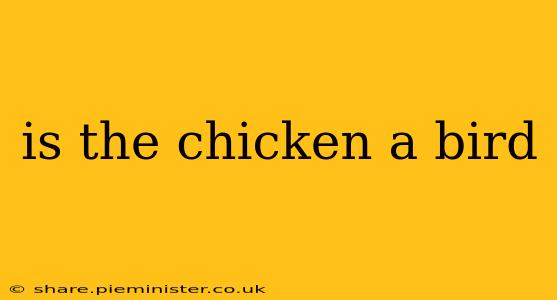Yes, the chicken is absolutely a bird. This might seem like a simple question with an obvious answer, but delving deeper reveals fascinating insights into avian biology and the classification of species. Let's explore this seemingly straightforward topic in detail.
What Defines a Bird?
Before confirming the chicken's avian status, let's understand the characteristics that classify an animal as a bird. Birds are distinguished by several key features:
- Feathers: This is perhaps the most defining characteristic. All birds possess feathers, used for insulation, flight (in most species), and display. Chickens, with their distinctive plumage, clearly meet this criterion.
- Beaks: Birds lack teeth and instead possess beaks, which are adapted to their specific diets. The chicken's beak is perfectly suited for pecking at the ground for seeds and insects.
- Wings: While not all birds use their wings for powered flight (think penguins or ostriches), the presence of wings is a defining feature. Chickens have wings, though they're primarily used for balance and short flights.
- Laying Eggs: Birds reproduce by laying hard-shelled eggs. This is a fundamental aspect of avian reproduction, and chickens, of course, are renowned for their egg-laying abilities.
- Skeletal Structure: Birds possess a unique skeletal structure, including hollow bones (in many species) to reduce weight for flight. While chicken bones aren't as dramatically hollow as those of some flying birds, their skeletal structure aligns with avian characteristics.
- Warm-Blooded: Birds are endothermic, meaning they regulate their own body temperature. Chickens maintain a constant internal body temperature, further confirming their classification as birds.
What Scientific Classification Tells Us
Taxonomically, chickens belong to the kingdom Animalia, phylum Chordata, class Aves (birds), order Galliformes, family Phasianidae, genus Gallus, and species Gallus gallus domesticus. The classification firmly places chickens within the Aves class, leaving no doubt about their avian status.
What About Flightless Birds?
The fact that chickens aren't strong fliers doesn't negate their classification as birds. Many bird species have lost or significantly reduced their ability to fly over evolutionary time, adapting to terrestrial lifestyles. Ostriches, emus, and penguins are prime examples of flightless birds. Their inability to fly doesn't change their fundamental avian characteristics.
Are Chickens Dinosaurs?
This is a fascinating question that opens another layer to the discussion. Scientific evidence strongly suggests that birds are the direct descendants of theropod dinosaurs. While chickens don't resemble the fearsome Tyrannosaurus Rex, their evolutionary lineage is connected to these ancient reptiles. This adds another dimension to understanding the chicken's place in the animal kingdom.
H2: Are all birds chickens?
Absolutely not! Chickens are just one species within the incredibly diverse class of Aves. There are thousands of bird species worldwide, exhibiting a stunning array of sizes, colors, behaviors, and adaptations. From tiny hummingbirds to massive ostriches, the variety within the avian class is breathtaking.
H2: What makes chickens different from other birds?
Chickens, being domesticated fowl, differ from other birds in several key ways:
- Domestication: Chickens are selectively bred for specific traits, such as egg production, meat yield, and temperament, leading to variations within the species that are not seen in wild birds.
- Behavior: Domesticated chickens exhibit behaviors adapted to human interaction and confinement.
- Physical Characteristics: Selective breeding has resulted in a range of body sizes, feather colors, and comb shapes not found in their wild counterparts.
In conclusion, the answer to "Is the chicken a bird?" is a resounding yes. This seemingly simple question opens a door to explore the fascinating world of avian biology, evolution, and the remarkable diversity within the bird class.
